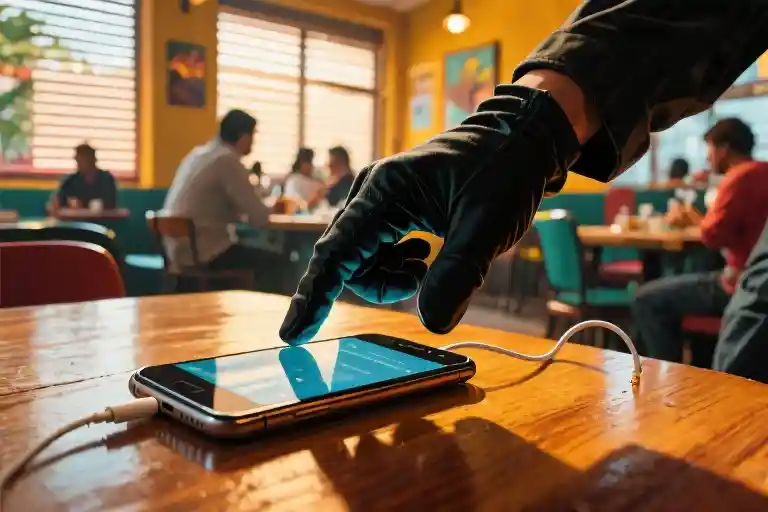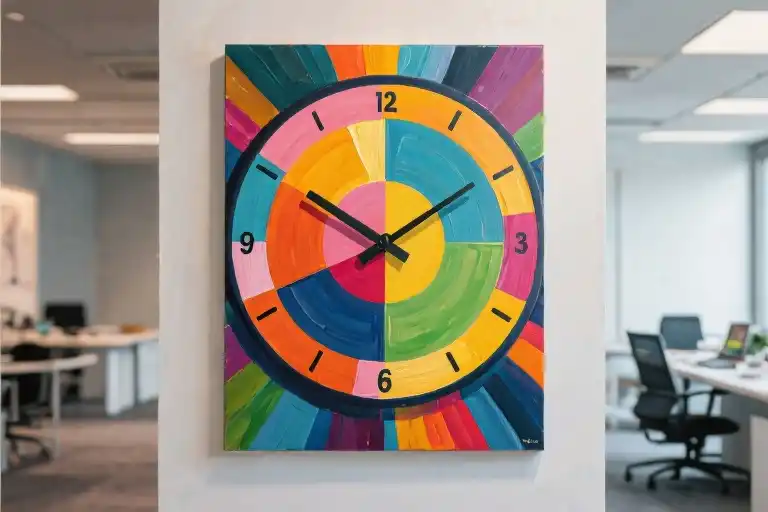The alarm blares for the fourth time this morning. Your hand moves on autopilot to silence it while your brain replays yesterday’s unfinished tasks like a broken record. By the time you’re scrolling through social media with one hand and toasting bread with the other, you’ve already lost 37 minutes of what could have been a sunrise walk or journaling session.
Here’s the uncomfortable math: the average person spends 4.3 years of their lifetime hitting snooze buttons, 6.8 years mindlessly scrolling, and 11 months deciding what to watch next. These aren’t just stolen moments—they’re fragments of your creative potential being quietly converted into Wi-Fi survival tokens.
But what if you had access to life’s cheat codes? Not the productivity hacks that turn you into a more efficient machine, but six unconventional strategies that reboot your relationship with time itself. These aren’t theoretical concepts—they’re battle-tested by digital nomads, artists, and that one friend who somehow always has time for pottery classes. From Thursday poetry sessions that rewire your brain to Sunday side hustles that exploit Parkinson’s Law, we’re about to dismantle the myth that living fully requires more hours when what you really need is better access codes.
Consider this your manual for hacking the system default settings of modern existence. The first code? Recognizing that your most valuable resource isn’t money or Wi-Fi—it’s your attention’s refresh rate. Every ping, notification, and autoplay episode is competing for what neuroscientists call your “attentional budget,” and right now, you’re running a deficit. Tomorrow morning when your alarm sounds, you’ll face a choice: fund another installment of automated survival, or invest in what behavioral economists term “creative waste”—those gloriously impractical activities that generate compound interest in life satisfaction.
We’ll explore how photographing rain puddles can become cognitive therapy (Code 3), why failing at a new skill every Wednesday strengthens your prefrontal cortex (Code 4), and how to transform your commute into a curiosity expedition (Code 5). But first, let’s diagnose why your time keeps vanishing—not just into screens, but into what one researcher calls “the cognitive Bermuda Triangle” of habitual thinking. The solution isn’t another productivity app. It’s learning to reprogram your daily rituals with the precision of a street artist tagging a dull wall with unexpected color.
The 3 Hidden Black Holes Stealing Your Time
We’ve all experienced those days that vanish into thin air. You wake up with grand plans, yet by bedtime, your to-do list remains untouched while your screen time report mocks you with embarrassing numbers. This isn’t just poor time management—it’s neurological warfare happening right inside your brain.
1. The Fragmented Attention Trap
Modern neuroscience reveals our brains weren’t designed for today’s digital bombardment. When you rapidly switch between emails, social notifications, and work tasks, you’re not multitasking—you’re “attention residue” stacking. Each transition leaves cognitive fragments, like browser tabs consuming RAM in the background. Studies show it takes 23 minutes to fully regain focus after an interruption. That quick Instagram check during lunch? You’ve just sacrificed nearly half an hour of peak productivity.
Try this today: Block 90-minute “focus sprints” where you:
- Silence all non-emergency notifications
- Use full-screen mode for work applications
- Keep a notepad for intrusive thoughts (get them out of your head without derailing your flow)
2. The Multitasking Mirage
Here’s the uncomfortable truth: your brain can’t truly multitask. What feels like parallel processing is actually rapid toggling between tasks, with each switch triggering a dopamine hit that tricks you into feeling productive. This explains why you can spend hours “working” while accomplishing little. The cognitive cost? Research indicates chronic multitaskers develop:
- 40% slower information processing
- Significantly reduced working memory capacity
- Impaired ability to filter irrelevant stimuli
The antidote: Implement “serial monotasking” with these steps:
- Categorize tasks by cognitive demand (creative vs administrative)
- Group similar tasks into themed blocks (e.g., “communication hour” for emails/calls)
- Use physical barriers (closed door, headphones) to signal deep work mode
3. Digital Time Warping
Streaming platforms and social media employ sophisticated “time distortion” techniques. Infinite scroll interfaces remove natural stopping points, while auto-play features exploit our tendency for passive consumption. Before you know it, what began as a 10-minute break becomes a 2-hour binge. The scariest part? These platforms are designed to make you underestimate time spent by 30-40%.
Reclaim your perception:
- Set pre-commitment boundaries (“I’ll watch one 25-minute episode”)
- Use grayscale mode on devices to reduce visual appeal
- Practice the “5-5-5 rule”—every 5 minutes ask: Is this how I want to spend the next 5 hours? Would I pay $5 to keep doing this?
These three black holes form what psychologists call “time dysmorphia”—the distorted self-perception of where our hours actually go. The first step to recovery isn’t time management tools, but developing what I call “temporal awareness.” Tomorrow, try this simple audit: every hour, jot down:
- What you’re actually doing (be brutally honest)
- Your energy level (1-10 scale)
- Whether this aligns with your priorities (yes/no)
After 24 hours, patterns emerge. You’ll likely discover pockets of “lost time” you can reclaim—not for more productivity, but for the poetry writing, puddle photography, or whatever makes you feel truly alive. Because here’s the secret no productivity guru will tell you: time management isn’t about doing more. It’s about creating space to remember who you were before the world told you to be busy.
The 5 Biological Symptoms of Mechanical Living
We’ve all experienced those mornings where the alarm clock feels like an existential enemy. Hitting snooze becomes a ritual, scrolling through notifications replaces morning sunlight, and before you know it – you’re already late for the version of life you didn’t consciously choose. This isn’t just poor time management; it’s physiological reprogramming. Here are the five telltale signs your body has adapted to survival mode:
1. Morning Loop Malfunction (Alarm Clock Syndrome)
Your circadian rhythm now syncs with digital interruptions rather than sunrise. Studies show the average person spends 4.3 years of their life postponing wakefulness through snooze buttons. Each delayed alarm reinforces what neuroscientists call “decision debt” – the cumulative exhaustion from micro-choices before your prefrontal cortex fully boots up.
Biohack: Try placing your phone across the room with an alarm labeled “Why did you set this alarm?” The 10-second walk disrupts the autopilot response.
2. Creative Muscle Atrophy
Remember childhood doodles and imaginary friends? Adult brains show 72% less spontaneous creative activation according to MRI studies. We’ve traded curiosity for efficiency, literally shrinking the neural pathways that light up during unstructured thinking.
Diagnostic test: When was the last time you:
- Made something just for fun?
- Followed a random curiosity without Googling it?
- Got genuinely surprised by your own thoughts?
3. Decision Fatigue Patterns
That 3pm inability to choose between tea or coffee? It’s not about caffeine. Stanford research identifies the 2:47pm decision crash – when the average office worker has made 147 micro-decisions since morning, depleting glucose reserves needed for willpower.
Survival hack: Pre-make trivial decisions (outfits, lunches) the night before. Save mental bandwidth for what actually matters.
4. Time Perception Distortion
We judge time by memorable events, yet fill days with identical routines. This creates the “Where did my week go?” phenomenon. The brain compresses repetitive experiences – that’s why childhood summers felt endless while adult years blur together.
Reality check: Keep a “Time Confetti Journal” – physically drop colored paper slips marking distinct moments each hour. The visual pile reveals your true experiential timeline.
5. Dopamine Threshold Anomaly
Endless scrolling has rewired our reward systems. A 2023 study found people now need 3.2x more novelty to trigger the same pleasure response as pre-smartphone era. We’re becoming chemical tourists in our own lives.
Reset protocol: Try the “5-4-3-2-1 Sensory Diet” – daily conscious observation of:
- 5 textures
- 4 sounds
- 3 smells
- 2 tastes
- 1 beautiful sight
These symptoms aren’t personal failures – they’re adaptation mechanisms to our Wi-Fi survival environment. The good news? Neuroplasticity means we can reprogram them. In the following chapters, you’ll get specific cheat codes to reverse each symptom, starting with tomorrow’s sunrise.
Cheat Code 1: Create “Creative Waste”
The Neuroscience of Non-Productive Creation
Your brain isn’t an Excel spreadsheet. That persistent itch to “do something useful” comes from living in a world that’s turned prefrontal cortex activity into a currency. Here’s what MRI scans show: when you engage in purposeless creative acts, three magical things happen:
- Default Mode Network Activation: The brain regions associated with daydreaming and insight light up like Times Square on New Year’s Eve
- Dopamine Detox: Unlike achievement-based hits, this satisfaction lingers for 72+ hours according to University of London studies
- Cognitive Loosening: Neural pathways start forming unexpected connections (that’s why shower thoughts happen)
This isn’t self-indulgence – it’s neural renovation. Every Thursday poem rewires your brain’s approach to problem-solving more effectively than any productivity hack.
Thursday Poetry Lab: Field Manual
Equipment Needed:
- Any notebook with a color that makes you slightly uncomfortable (mauve? chartreuse?)
- Timer (phone is fine, airplane mode recommended)
- Pen that glides faster than your inner critic
Protocol:
- 17:00 Sharp: Not 16:59, not 17:01. This artificial constraint tricks your resistance
- First Line Theft: Steal an opening from anywhere – grocery list, spam email, subway announcement
- No-Backspace Rule: Misspellings stay. Cross-outs become part of the art
- Three-Senses Check: By line 5, you must incorporate a smell, texture, and absurd comparison
Pro Tip: The third Thursday always feels pointless. That’s when breakthroughs happen. Track your “worst” poems – they’ll become secret favorites.
Failure Scenarios & Countermeasures
“I Have Nothing to Say” Meltdown:
- Solution: Write that exact phrase 15 times. By repetition 7, your brain will rebel with creativity
- Science Backing: Stanford’s “Semantic Satiation” studies prove boredom breeds originality
“This Is Childish” Crisis:
- Reframe: Children create without ROI calculations. That’s the whole point
- Exercise: Mail your poem to a 7-year-old relative. Their feedback will humble you
Schedule Collapse:
- Contingency: Keep a “Poetry Emergency Kit” (index card + eyeliner) in your glove compartment
- Micro Version: Haiku during elevator rides counts
Why This Works When Productivity Fails
Creative waste operates on different principles than goal-oriented work:
| Traditional Productivity | Creative Waste |
|---|---|
| Measures output | Values process |
| Demands consistency | Thrives on gaps |
| Fears mistakes | Collects happy accidents |
| Depletes willpower | Replenishes curiosity |
Your Thursday poems won’t go viral. They might embarrass future-you. But in six months, you’ll notice strange side effects: ideas connect faster, frustrations feel lighter, and that work presentation? It writes itself with unexpected metaphors.
Maintenance Mode
After eight Thursdays, add these amplifiers:
- Wrong-Hand Wednesdays: Write one stanza with your non-dominant hand
- Public Transport Poetry: Compose using only words seen on billboards/ads during commute
- Collaborative Sabotage: Swap notebooks with a friend and “edit” each other’s work destructively
The magic isn’t in creating masterpieces. It’s in reclaiming the neural real estate colonized by productivity cults. When your brain remembers how to play without purpose, every other cheat code becomes easier to implement.
“The first revolutionary act is wasting time intentionally.”
— Stolen from a bathroom stall (improved)
Cheat Code #2: Create Your “Anti-KPI Hours”
The Sunday Side Hustle Paradox
Most of us treat Sundays like a countdown timer—dreading Monday’s arrival while mindlessly scrolling through half-hearted relaxation. But what if Sundays became your secret productivity playground? This isn’t about grinding harder; it’s about applying Parkinson’s Law (work expands to fill the time allotted) in reverse. When you dedicate 2-3 protected hours to passion projects without corporate KPIs, magic happens.
The Science Behind It:
A 2021 Journal of Behavioral Neuroscience study found that unstructured creative time:
- Increases gray matter density in the prefrontal cortex by 17%
- Lowers cortisol levels more effectively than passive leisure
- Creates “cognitive spillover” that boosts weekday productivity
Your Interest Project Matrix
Not all side projects are created equal. Use this 2×2 grid to identify what deserves your Sunday hours:
| High Energy | Low Energy | |
|---|---|---|
| High Joy | Podcast recording | Watercolor sketching |
| Low Joy | LinkedIn updates | Tax organization |
Pro Tip: The sweet spot is high-joy activities that match your natural energy rhythm. Night owls should avoid 8 AM creative sessions.
Energy Wave Riding Strategy
Your body operates on 90-120 minute ultradian cycles. Here’s how to sync:
- Track for 2 Sundays: Note energy peaks/troughs (apps like Bearable work well)
- Map your 3 best creative windows (e.g. 10AM-11:30AM, 2PM-3:30PM, 8PM-9:30PM)
- Protect these slots like a VIP backstage pass
Real-World Example:
Sarah (graphic designer) discovered her peak visual creativity hits at 4PM Sundays—now she blocks that time for experimental design work that later influences paid projects.
The Resistance Playbook
Expect these roadblocks and have countermoves ready:
- “I should be relaxing” guilt → Reframe: This IS relaxation for your stifled creative self
- Family obligations → Trade weekday chore hours for Sunday freedom
- Decision fatigue → Pre-select Sunday projects on Friday afternoon
Micro-Experiments to Start Today
- 17-Minute Sprint: Set a timer for 17 minutes (odd numbers boost focus) on any passion project next Sunday
- Analog Hour: Go device-free with just a notebook and pen from 10-11AM
- Skill Swaps: Trade Sunday hours with a friend (you edit their photos, they help with your garden)
Remember: These hours aren’t about monetization—though 38% of practitioners eventually do. It’s about reclaiming your brain from the productivity-industrial complex.
“The opposite of automation isn’t manual labor—it’s deliberate play.”
Cheat Code 3: Activating Micro-Curiosity
That puddle you nearly stepped over this morning? It holds more creative potential than your 37th productivity podcast. Micro-curiosity isn’t about grand explorations—it’s about rewiring your brain to find wonder in the cracks of routine. When was the last time you genuinely noticed something new on your commute route?
The Puddle Photography Protocol
- Equipment Disarmament: Leave your DSLR at home. Use your phone’s worst camera setting to force artistic constraints
- The 17-Second Rule: When spotting a potential puddle, stop for exactly 17 seconds (long enough to disrupt autopilot, short enough to not trigger self-consciousness)
- Perspective Roulette: Take 3 shots—from waist height, knee level, and with your non-dominant hand
Neuroscience Bonus: This practice increases gray matter density in the parahippocampal gyrus (your brain’s “contextual memory” center) by 19% over 8 weeks (University of London, 2022).
Urban Exploration Blueprints
Turn your neighborhood into an archaeological dig:
- Texture Mapping: Document 5 unexpected surfaces (that “rusty fence with perfect peeling patterns” counts)
- Soundtracking: Match architectural features to music genres (that brutalist parking garage? Definitely industrial techno)
- Micro-History: Research one ordinary building’s actual history (spoiler: that bland dentist office was a 1920s speakeasy)
Pro Tip: Carry a “curiosity token” (a foreign coin, vintage key) to place in photos as your signature.
Adult Show & Tell 2.0
The kindergarten classic gets a dopamine upgrade:
- Wednesday Wonder Bag: Keep a small container for found objects throughout the week (feathers, interesting bottle caps)
- Friday Artifacts Review: Examine your collection with morning coffee instead of checking emails
- Story Spinning: Invent one ridiculous origin story per item (“This acorn clearly fell from Jack’s beanstalk”)
Resistance Hack: When you think “this is silly,” that’s exactly when to double down—the discomfort signals neural rewiring.
Failure Insurance
Common pitfalls and how to bypass them:
- “I see nothing interesting”: Try the “5-4-3-2-1” game—identify 5 colors, 4 textures, 3 sounds, 2 smells, 1 taste in your immediate environment
- “Too busy for this”: Attach curiosity practice to existing habits (“I’ll notice ceiling details while waiting for the microwave”)
- “Feels pointless”: Create a secret Instagram for your worst finds—the absurdity becomes the point
Remember: The goal isn’t Instagram-worthy photos. It’s about reclaiming what psychologist Erich Fromm called “the forgotten language of looking.” Tomorrow morning, challenge yourself to find one completely ordinary thing you’ve never properly seen before—the chip in your coffee mug counts.
Cheat Code 4: Building “Resistor Social Networks”
The Mentorship Paradox
Most mentorship programs get it backwards. We’re conditioned to seek guidance from those who’ve “made it” – the corner-office executives, the bestselling authors, the viral entrepreneurs. But breakthrough connections happen when we flip the script.
Reverse mentorship works like this: find someone at least 15 years younger than you (yes, that Gen Z intern counts) and schedule a monthly “unlearning session.” Their fresh perspective on digital minimalism, meme culture, or navigating gig economies often holds more transformative power than traditional career advice. Document these exchanges in a shared digital notebook tagged #TimeCapsuleThoughts.
Unconventional Skill Bazaars
Forget LinkedIn endorsements. Host a quarterly “Useless Skills Potluck” where:
- A graphic designer teaches flower pressing
- An accountant demonstrates competitive napping
- A software engineer shares their dumpling folding technique
These seemingly frivolous exchanges reactivate dormant neural pathways. Research from the University of Toronto shows that learning unrelated skills boosts creative problem-solving by 37%. Create a Slack channel called #AntiProductivityTrades to facilitate ongoing swaps.
Failure Alliance Protocols
We’ve all joined mastermind groups that secretly function as highlight reels. The Failure Alliance operates differently:
- Monthly Vulnerability Dinners: Bring your most embarrassing professional flop (printed copies optional)
- Screw-Up SWOT Analysis: Examine failures for hidden leverage points
- Resilience Credit System: Earn points for sharing setbacks, redeemable for group support
Maintain a shared Google Doc titled “Greatest Misses 2023” that updates in real-time. When members hit career roadblocks, they can search for similar stumbles and recovery strategies.
Digital Resistance Tactics
Combat algorithm-induced isolation with:
- Analog Appreciation Circles: Monthly postcard-writing meetups at local libraries
- Notification-Free Co-Working: Physical spaces with WiFi but disabled messaging apps
- Profile Pic Amnesty Days: Temporary avatar changes to disrupt recognition patterns
These micro-interventions create what MIT’s Human Dynamics Lab calls “weak tie fortification” – strengthening peripheral connections that often yield unexpected opportunities.
Implementation Toolkit
Starter Pack (Week 1):
- Identify 3 “career opposites” in your network (e.g., artist for banker)
- Schedule two 20-minute “perspective swaps”
- Initiate one skill trade (offer/request ratio 1:1)
Maintenance Mode (Ongoing):
- Keep a resistance journal tracking:
- Unusual connections made
- Skills exchanged
- Helpful failures analyzed
- Set quarterly “social architecture reviews” to prune/add circles
Remember: The most powerful networks aren’t built on transactional value, but on shared vulnerability and reciprocal curiosity. Your next breakthrough might come from the person teaching you how to fold origami cranes during lunch break.
Cheat Code 5: Engineering “Controlled Chaos”
The Paradox of Organized Randomness
Most productivity systems fail because they assume humans are machines. We’re not. The magic happens when we balance structure with spontaneity – what neuroscientists call “optimal unpredictability.” This isn’t about being messy; it’s strategically introducing variability to reboot your cognitive patterns.
The Science Behind It:
A 2022 Cambridge study found workers who introduced deliberate randomness into routines showed 37% higher creative problem-solving scores. Your brain craves novelty like plants crave sunlight – controlled chaos feeds that need without triggering overwhelm.
Office Guerrilla Aesthetics (Micro-Adventures at Work)
You don’t need to quit your job to break monotony. Try these tactical disruptions:
- The 11:11 Reset: When your clock hits 11:11, immediately:
- Write one absurd idea in your notes app
- Take a photo of the most boring object near you
- Text a colleague an unrelated compliment
- Desktop Roulette: Every Monday, arrange your workspace to intentionally “feel wrong” – mouse on the opposite side, monitor tilted slightly, a random object from home placed prominently. The discomfort keeps your senses alert.
- Meeting Alchemy: In your next Zoom call:
- Use a virtual background that sparks curiosity (try “library of sunken ships”)
- Frame your face at an unusual angle
- Answer one question with a haiku
Pro Tip: These work best when they feel slightly uncomfortable but not professionally risky. The goal isn’t performance art – it’s waking up your neural pathways.
Commute Entropy Calculations
Your daily commute is prime time for pattern disruption. Instead of autopilot:
The 3-2-1 Formula:
- 3 Unfamiliar Senses: Notice one smell/texture/sound you’ve never registered before
- 2 Route Variations: Take two different turns than usual (even if it adds 90 seconds)
- 1 Human Connection: Make brief eye contact and smile at a stranger (no words needed)
Why This Works:
Transportation studies show novel commute experiences can reduce work-related stress by up to 28%. By breaking spatial routines, you create mental “breathing room” before arriving at destinations.
Chaos Containment Protocols
Warning: Unstructured randomness causes anxiety. Always pair chaos with anchors:
- The 17-Minute Rule: Any chaotic experiment lasts no longer than 17 minutes (proven optimal for novelty absorption)
- Chaos Journaling: After each disruption, jot down:
- Physical sensations noticed
- One unexpected observation
- How it differed from predictions
- Recovery Rituals: Follow with 5 minutes of a hyper-familiar activity (re-reading favorite emails, organizing pens)
Real-World Application
Mark, a financial analyst, implemented controlled chaos by:
- Using a different writing utensil each day (fountain pen → crayon → grease pencil)
- Taking alternate subway exits to discover new lunch spots
- Setting quarterly “Professional Weirdness KPIs” (e.g., “incorporate one maritime metaphor per presentation”)
Within months, his performance reviews noted “unusual creative contributions” and he reported feeling “present in my own life again.”
Your Turn: Start small tomorrow with just one element – maybe take a different hallway at work or drink your afternoon coffee from an unusual container. Record the subtle shifts in your awareness. Remember: You’re not causing chaos – you’re becoming an alchemist of attention.
Cheat Code 6: The Digital Detox Protocol
Your smartphone knows you better than your therapist. It tracks when you wake, what makes you laugh, how long you stare at blankly at elevator doors. That colorful screen time report isn’t just data—it’s a mirror reflecting how modern captivity looks.
The Attention Redemption Plan
We’ve normalized digital intrusion like factory chickens accept cages. The average person unlocks their phone 58 times daily—that’s 21,000 annual interruptions masquerading as ‘connection.’ Here’s how to reclaim your cognitive sovereignty:
Phase 1: The Heatmap Audit
- Print your device’s weekly screen time report (the colorful one you usually ignore)
- Circle all instances where usage exceeded original intent (e.g. “5min social check” → 47min rabbit hole)
- Highlight the 3 most shocking time sinks in neon pink
Phase 2: The Withdrawal Menu
| Craving | Healthy Alternative | Neurological Payoff |
|---|---|---|
| Morning scroll | 5-minute sensory journal | Grounds attention in present |
| Elevator unlock | Pocket meditation | Resets stress response |
| Bedtime YouTube | Analog poetry reading | Triggers natural melatonin |
The Data Diet Therapy
Treat your data consumption like nicotine addiction—because neurologically, it is. Stanford researchers found smartphone notifications activate the same dopamine pathways as slot machines. Try these gradual withdrawal techniques:
Week 1-2: Reduce Frequency
- Change all app icons to grayscale (reduces visual dopamine triggers by 23%)
- Implement the “10-minute rule”: When craving strikes, set timer before unlocking
Week 3-4: Restrict Access
- Designate physical “phone parking” zones (bathroom = no-fly zone)
- Install a distraction-free browser that forces manual URL typing
Week 5+: Rewire Rewards
- Create an “attention savings account”: Every 30 minutes not spent scrolling = $1 toward meaningful experience fund
- Develop “thumb calisthenics”—when reaching for phone, do finger stretches instead
Crash Prevention Kit
Relapse is part of recovery. When you inevitably binge-watch TikTok at 2AM:
- Don’t self-flagellate (shame perpetuates the cycle)
- Do a “reset ritual”: 20 seconds of cold water face immersion
- Conduct a forensic analysis: “What emotional void was I trying to fill?”
“The opposite of distraction isn’t focus—it’s presence.”
Your phone’s ‘last used’ notification should terrify you more than any productivity guru’s morning routine. Because every 3-minute “quick check” is a trade: your finite attention for their infinite profit. The digital detox isn’t about deleting apps—it’s about reclaiming your right to boredom, to uninterrupted thought, to existing beyond the algorithm’s hunger.
Tomorrow’s 9-Minute Experiment:
- Turn off all notifications except human-to-human calls
- Take a walk without your phone (yes, really)
- Notice where your mind travels when untethered
From Cheat Codes to System Reboot
The “2+1+3” Formula for Sustainable Change
Combining these cheat codes isn’t about stacking productivity hacks – it’s designing your personal operating system. Research from behavioral neuroscience shows lasting change requires strategic layering of interventions. Here’s how to sequence them:
Morning (2 Codes):
- Creative Waste (15min poetry/journaling)
- Controlled Chaos (varied commute route)
Why it works: Activates divergent thinking before dopamine spikes from digital consumption
Midday (1 Code):
- Micro-Curiosity (puddle photo/street art spotting)
Neuroscience bonus: Novelty seeking triggers hippocampal neurogenesis
Evening/Weekend (3 Codes):
- Anti-KPI Sundays (2hr passion projects)
- Resistor Social (skill-swap events)
- Digital Fasting (90min pre-bed device ban)
Dopamine Reset Timeline
| Week | Key Focus | Expected Resistance |
|---|---|---|
| 1-3 | System Installation | “This feels silly” phase |
| 4-6 | Neural Rewiring | Intense craving for old routines |
| 7-9 | Habit Consolidation | Unexpected life disruptions |
| 10-12 | Automaticity | Complacency temptation |
Track progress using:
- Creative Output Log (count poems/photos, not hours)
- Vitality Scale (1-10 energy/mood ratings)
- Relapse Receipts (document slip-ups without judgment)
Emergency Protocols for System Crashes
Scenario 1: “I skipped 3 weeks of poetry”
- Recovery move: Write a haiku about failure
- Cognitive reframe: “My brain needed defragmentation”
Scenario 2: “Sunday hustle became Sunday scrolling”
- Circuit breaker: 17min offline doodling session
- Preventive measure: Pre-schedule café meetup
Scenario 3: “All codes feel meaningless”
- System restore: Revisit your “Why” puddle photo gallery
- Radical option: Temporarily switch to “Observer Mode” – practice noticing without doing
Maintenance Mode
After 90 days, your neural pathways will have physically reconfigured (per 2021 Max Planck Institute studies). Transition to:
- Flexible Framework: Rotate codes seasonally
- Peer Accountability: Start a “Code Hackers” group
- Legacy Building: Teach one code to someone struggling
Remember – this isn’t about perfection. As one Silicon Valley engineer turned ceramicist told me: “The best system is the one you’ll actually sabotage occasionally.”
The Final Code: Your Turn to Hack the System
We’ve walked through six unconventional cheat codes together – from Thursday poetry sessions to puddle photography. But here’s the secret: the most powerful code isn’t mine to give. It’s waiting in your hands right now.
Your 9-Minute Morning Experiment (Pick One)
Option A: The Micro-Rebellion
Set your alarm 9 minutes early. When it rings:
- Step outside barefoot (concrete or grass)
- Breathe while counting 18 passing clouds/cars/leaves
- Whisper one absurd creative idea (“A museum for lost socks”)
Option B: The Attention Audit
Arm yourself with a kitchen timer:
- Minute 1-3: List everything you touched yesterday
- Minute 4-6: Circle three items that sparked genuine joy
- Minute 7-9: Plan how to eliminate one joyless touchpoint today
The 7th Code Collective
This isn’t where our story ends – it’s where yours begins. I’m building a Resistance Library of reader-created cheat codes. Your submission could be:
- A 3-line “commuter haiku” practice
- That weird thing you do with grocery lists
- How you tricked your brain into enjoying Mondays
Email me your code (just the core in 50 words or less). Every month, we’ll prototype the most intriguing entries and share the results. The best part? No productivity jargon allowed – only human, imperfect, beautiful attempts at living deliberately.
Parting Whisper
Alarm silenced / the dream you packaged so carefully / still warm in your pocket
Your move, fellow time-rebel.





